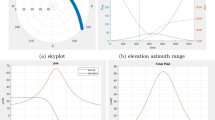Abstract
Point ahead angle (PAA) prediction is important in space laser communication, but the existing methods have low accuracy and complicated calculation processes. In this paper, a new PAA prediction method is proposed based on Kalman filtering of the optical axis pointing trajectory. The proposed method uses the high precision of fine tracking to improve the accuracy of predictive filtering. Taking ground-satellite laser communication as the research background, the beam transmission process in a typical acquisition, pointing, and tracking (APT) system is derived, then the Kalman filter model is established, and a simulation of the model is performed. The results show that the PAA can be predicted accurately and the error of the PAA can be reduced effectively the maximum prediction error is 3.8 μrad only, and the method does not need to take the complex satellite perturbations into consideration. The proposed approach improves the accuracy of PAA prediction and contributes to the design of space laser communication systems.







Similar content being viewed by others
References
Zhang, F., Han, J., Ruan, P.: Beam pointing analysis and a novel coarse pointing assembly design in space laser communication[J]. Optik 189, 130–147 (2019)
Xu, G.: Error performance of deep space optical communication with M-ary pulse position modulation over coronal turbulence channels[J]. Opt. Express 27(9), 13344–13356 (2019)
Li, Q., Xu, S., Yu, J., et al.: An improved method for the position detection of a quadrant detector for free space optical communication[J]. Sensors 19(1), 175 (2019)
Xu, G., Song, Z.: Effects of solar scintillation on deep space communications: challenges and prediction techniques[J]. IEEE Wirel. Commun. 26(2), 10–16 (2019)
Zhao, X., Liu, Y., Song, Y.: Line of sight pointing technology for laser communication system between aircrafts[J]. Opt. Eng. 56(12), 126107 (2017)
Sun, X., Skillman, D.R., Hoffman, E.D., et al.: Free space laser communication experiments from Earth to the lunar reconnaissance orbiter in lunar orbit[J]. Opt. Express 21(2), 1865 (2013)
Wuchenich, D.M.R., Mahrdt, C., Sheard, B.S., et al.: Laser link acquisition demonstration for the GRACE follow-on mission[J]. Opt. Express 22(9), 11351–11366 (2014)
Kern, R.H., Kugel, U.: Pointing, acquisition and tracking (PAT) subsystems and components for optical space communication systems[C]. Opt. Space Commun. Int. Soc. Opt. Photonics 1131, 97–107 (1989)
Greenwald, D., Mclaughlin, C.: A beacon tracker and point ahead system for optical communications[C]. Proc. SPIE 103(2), 268–276 (1989)
LeFebvre, M.J., Cuellar, E.L., Taylor, G.L., Stahl, S.M., Barrett, T.K., Sandler, D.G.: Point-ahead-compensated illumination tests using the 500-channel innovative science and technology experimental facility adaptive optics system[C]. Proc. SPIE 2201, 373–380 (1994)
Wang, M.L., Wang, X.F.: Analysis of lagrange interpolation algorithm for satellite position and velocity[J]. Aeronaut. Comput. Tech. 38(4), 14–17 (2008)
Dan, L.I., Yang, Y.: Prediction algorithm of close-orbit satellite based on orbit elements[J]. Opt. Precis. Eng. 24(10), 2450–2458 (2016)
Yan, L.J.: Research on Line-of-sight Pointing and Prediction Technology for Electro-optical Telescope[D], pp. 93–122. University of Chinese academy of sciences, Beijing (2019)
Lingjie, Y., Yongmei, H., Yahui, Z.: Using allan variance based semi-parameter model to calibrate pointing errors of Alt-az telescopes[J]. Appl. Sci. 8(4), 614 (2018)
Wilson K, Kenny J, Moynihan P.: Plans for a STRV-2 to AMOS high data rate bi-directional optical communications link (2000)
Soysal, G., Efe, M.: Kalman filter aided cooperative optical beam tracking[J]. Radio Eng. 19(2), 242–248 (2010)
Liu, N.: Acquisition and Tracking Strategies for Satellite to Ground Optical Communication Systems[D], pp. 51–59. Ryerson University, Toronto (2018)
Ye, T., Zhou, F.: Autonomous space target recognition and tracking approach using star sensors based on a Kalman filter[J]. Appl. Opt. 54(11), 3455 (2015)
Ljouad, T., Amine, A., Rziza, M.: A hybrid mobile object tracker based on the modified Cuckoo Search algorithm and the Kalman Filter[J]. Pattern Recogn. 47(11), 3597–3613 (2014)
Ye, X.W., Shen, F.: Orbit-dynamics model of spacecraft and error analysis of ahead-point[J]. Chin. J. Lasers 44(6), 50 (2017)
Shlomi, A., Kopeika, N.S.: Possible solutions to mitigate vibration effects in laser intersatellite links[C]. Proc. SPIE Int. Soc. Opt. Eng. 4489(3), 1436–1443 (2002)
Czarnomski, M., et al.: Laser communications for unmanned aircraft systems using differential GPS and IMU data. Proc. SPIE 7587, 758709 (2010)
Boucher, C., Altamimi, Z.: ITRS, PZ-90 and WGS 84: current realizations and the related transformation parameters[J]. J. Geod. 75(11), 613–619 (2001)
Fu, J.J., Yan, C.X., Liu, W., et al.: Stiffness calculation and optimal design of elliptical flexure hinges[J]. Opt. Precis. Eng. 7, 1703–1710 (2016)
Wu, R., Zhao, X., Tian, C., et al.: Improving line-of-sight pointing accuracy of laser communication system based on Kalman filter[J]. Opt. Eng. 58(1), 016110.1–016110.7 (2019)
Mahapatra, P.R., Mehrotra, K.: Mixed coordinate tracking of generalized maneuvering targets using acceleration and jerk models[J]. IEEE Trans. Aerosp. Electron. Syst. 36(3), 992–1000 (2000)
Liu, Y., Suo, J., Karimi, H.R., et al.: A Filtering Algorithm for Maneuvering Target Tracking Based on Smoothing Spline Fitting[J]. Abstr. Appl. Anal. 6, 1–6 (2014)
Acknowledgements
This article was supported by the 135 project of Institute of Chinese academy of sciences (NO. Y655811213). We would like to thank Editage (www.editage.cn) for English language editing.
Author information
Authors and Affiliations
Corresponding author
Additional information
Publisher's Note
Springer Nature remains neutral with regard to jurisdictional claims in published maps and institutional affiliations.
Rights and permissions
About this article
Cite this article
Furui, Z., Ping, R. & Junfeng, H. Point ahead angle prediction based on Kalman filtering of optical axis pointing angle in satellite laser communication. Opt Rev 27, 447–454 (2020). https://doi.org/10.1007/s10043-020-00608-6
Received:
Accepted:
Published:
Issue Date:
DOI: https://doi.org/10.1007/s10043-020-00608-6




